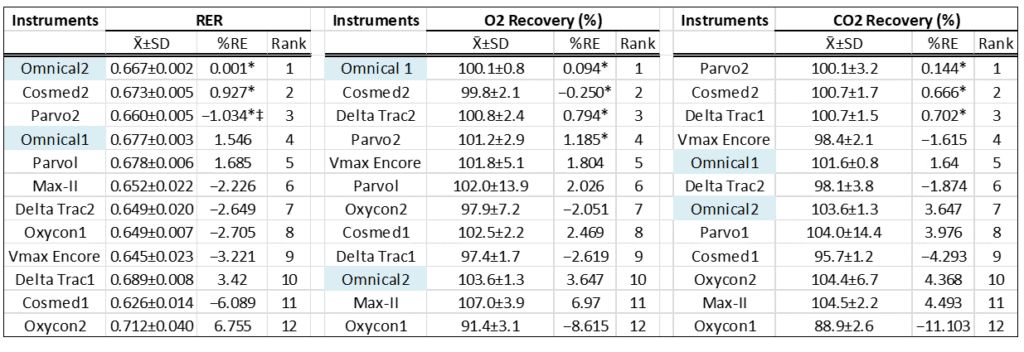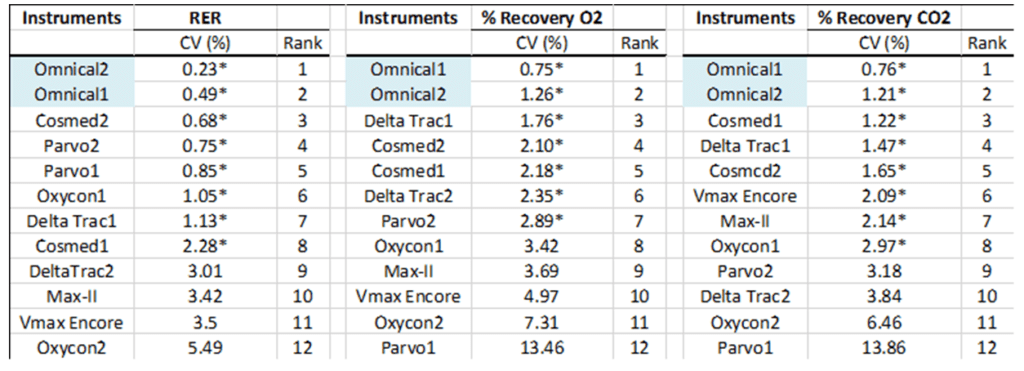Expired gas analysis indirect calorimetry is considered the “Gold Standard” for measuring resting energy expenditure, but do all indirect calorimeters perform the same?
It may be misleading to assume that results obtained from indirect calorimeters are rigorously correct. Such an assumption was previously highlighted by an article by Schadewaldt et al. 1 that raised questions about the precision and stability of different indirect calorimeters. The authors observed distinct variability in the volume of carbon dioxide produced (VCO2) and volume of oxygen consumed (VO2) measured between two calorimeters, which not surprisingly, propagated different metabolic derivative values (e.g. resting energy expenditure, respiratory quotient and substrate utilization). Indeed, there are several commercially available indirect calorimeters but accuracy and reliability data is lacking.
The issue of validity and reliability of indirect calorimeters was re-highlighted in a recent article by Kaviani et al2. The authors compared the performance of 12 indirect calorimeters using methanol burning test technique as the crition measure. Since methanol burning has predictable respiratory quotient values (theoretical Respiratory Exchange Ratio (RER) = 0.667, where RER = VCO2/VO2), the accuracy of an indirect calorimeter can be validated.
The test
A total of eight 20-minute methanol burning trials were completed on the 12 indirect calorimeters (two Cosmed Quark CPET, two DeltaTrac II, two Parvo Medics TrueOne 2400, two Iaeger Oxycon Pros, two Omnicals, a Vmax Encore, and a Max-II Metabolic System) at 11 international study sites. Methanol tests were performed at 0700, 1000, 1300, and 1600 hours on 2 consecutive days. Respiratory Exchange Ratio (RER) and percent (%) recovery of O2 and CO2 were calculated after each test.
Results
Accuracy
Accuracy of the instrument was based on ≤1.5% percent relative error from theoretical values, i.e. Respiratory Exchange Ratio (RER) = 0.667, and % Gas recovery = 100%. Table 1 shows the accuracy of the 12 indirect calorimeters tested and the instrument rankings based on % relative error from theoretical values. One instrument each from Omnical, Cosmed, and Parvo were accurate in measuring RER and % O2 recovery; one instrument from DeltaTrac was also accurate for % O2 recovery. The same Cosmed and Parvo, and the other DeltaTrac instrument were accurate in measuring % CO2 recovery.
Table 1: Accuracy of the 12 indirect calorimeters tested.

X̄ Average of eight methanol burning test, SD: Standard Deviation, %RE: Percent of Relative Error, RER: Respiratory Exchange Ratio.
‡ Negative %RE values indicate an average less than the theoretical value.
* denotes accurate instrument based on a %RE≤1.5%.
Reliability
Based on coefficient of variation (CV) of ≤3%, 8 instruments were shown to be reliable. Both Omnicals ranked best based on the smallest CV while both Cosmeds, Parvos, DeltaTracs and 1 Vmax were reliable instruments for at least one variable. Table 2 shows the reliability of the 12 indirect calorimeters tested and the instrument rankings based on CV of measurements by each instrument.
Table 2: Reliability of the 12 indirect calorimeters tested.

CV: Coefficient of Variation, RER: Respiratory Exchange Ratio.
* denotes reliable instrument based on a CV ≤ 3%.
Multiple Regression
Exogenous factors that are could affect the performance of indirect calorimeters are also important to consider. Humidity, amount of methanol combusted, and temperature were tested as predictors of measurement outcomes. Humidity and amount of combusted methanol were significant predictors of RER (F (2, 60) =10.91, p<0.001, R2>=0.33). Temperature and amount of burned methanol were significant predictors of O2 recovery (F (2, 60) =8.32, p<0.001, R2 while only humidity was a predictor for CO2 recovery (F (1, 61) =21.10, p<0.001, R2=0.15).
Conclusion
The Omnical, Cosmed, and Parvo showed superior accuracy and reliability; however, accuracy was only found at one of two study sites. Exogenous factors such as humidity and temperature may influence instrument performance and should be modified in the lab to improve the quality of respiratory exchange data.
Comments
Researchers need instruments that can supply highly reliable, validated result. Considering that indirect calorimeters do not perform equally, it is essential to choose an instrument with exceptional accuracy and reliability such as the Omnical . Maastricht instruments supplies the Omnical system that allows researchers to easily conduct various studies.
Contact us today for more information.
References
- Schadewaldt P, Nowotny B, Straßburger K, Kotzka J, Roden M. Indirect calorimetry in humans: a postcalorimetric evaluation procedure for correction of metabolic monitor variability. The American journal of clinical nutrition. 2013 Apr 1;97(4):763-73.
- Kaviani S, Schoeller DA, Ravussin E, Melanson EL, Henes ST, Dugas LR, Dechert RE, Mitri GE, Schoffelen PF, Gubbels P, Tornberg A. Determining the Accuracy and Reliability of Indirect Calorimeters Utilizing the Methanol Combustion Technique. The FASEB Journal. 2017 Apr 1;31(1 Supplement):433-3.
